Article
Volov V.V., Volov V.T. (2019). Innovative method for assessing neuropsychological status based on entropy approachers. National Psychological Journal, [Natsional’nyy psikhologicheskiy zhurnal], (12)4, 64–71
Abstract
Background. The paper presents an innovative quantitative method for assessing neuropsychic fatigue based on the entropy approach. The relevance of the work is connected with the need to determine the neuropsychic state and resistance to stress in different conditions of human activity. This approach is consistent with the trends of modern psychology research on self-organization in the aspect of identifying the processes that underly the stress response during overcoming physical and central fatigue. The proposed method includes the formula of conditional deterministic entropy, tools of nonequilibrium thermodynamics in its information interpretation (I. Prigogine’s theorem on the minimum of entropy production).
Objective. The approbation results of the criterion estimates of neuropsychic stability for the prediction of motor-motor capabilities, behaviour and state of the individual are shown.
Background. The study of students and athletes (71 boys and 72 girls, average age -20- + 3 years) was conducted based on the data provided by the Biological Faculty of Moscow Lomonosow State University. The approbation of the method carried out on the basis of the data of psycho-physiological indicators (tapping test) allowed to assess the stability of the neuropsychic state of athletes. Results. The data confirmed the validity of the method and made it possible to identify stable and unstable states associated with the growth of neuropsychic stress that may result in central fatigue.
Conclusion. The regularities revealed in the experimental samples do not only correspond to the data of the tapping test technique, but also show more accurate and qualitatively meaningful assessments of the neuropsychic stress and the state of the system as a whole. The approach makes it possible to create a device for monitoring neuropsychic stress, i.e. «Halter tapping», and also allows to make similar assessments of sports teams in the process of training, for example, for game sports.
Accepted: 11/12/2019
Pages: 64-71
DOI: 10.11621/npj.2019.0407
PDF: Download
Keywords: sport psychology; conditional entropy; stability criterion; neuropsychic fatigue; sport psychology; psychophysiology; tapping test; entropy approach;
Available Online 31.12.2019
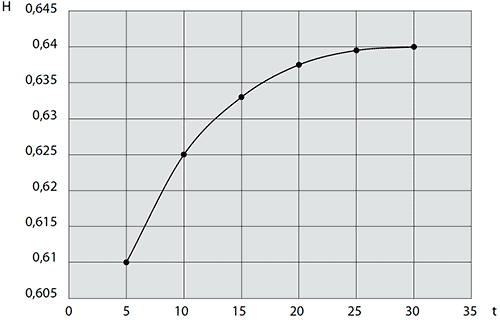
Fig. 1. Dependence of conditional entropy H in the tapping test with stable neuropsychic strain (d2H/dt2![]()
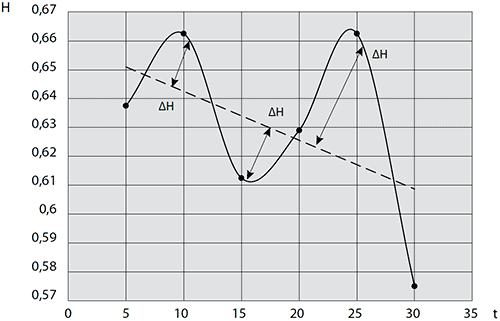
Fig. 2. Dependence of entropy H in a quasineutral neuropsychic state
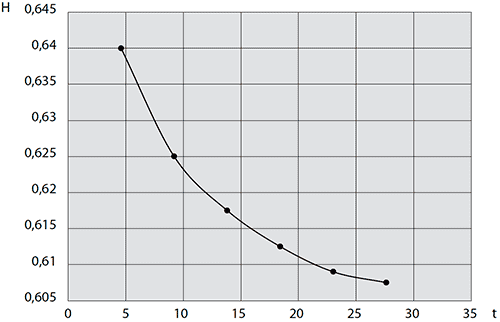
Fig. 3. Dependence of entropy H in unstable neuropsychic strain(d2H/dt2![]()
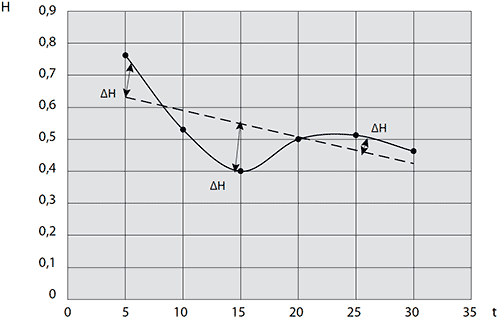
Fig. 4. Dependence of entropy H with a simultaneous increase in central fatigue and adaptation of the load![]()
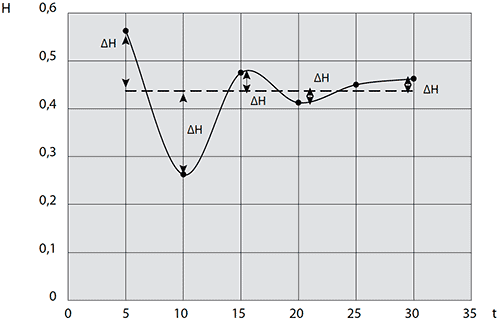
Fig. 5. The dependence of entropy H in the standard adaptation of the neuropsychic state of the subject to the load![]()
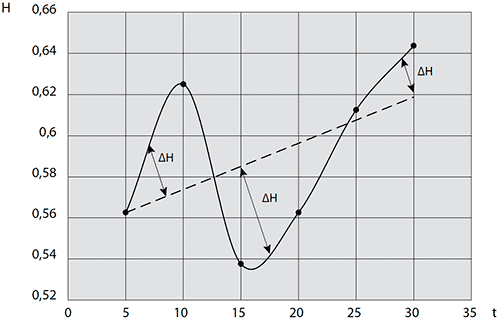
Fig. 6. Dependence of entropy H for subjects with a phenomenal possibility of stable adaptation to increasing load
References:
Anokhin P.K. (1980). Major issues of the theory of functional systems. Moscow, Nauka, 197.
Berg T.N. (2005) Neuropsychic instability and methods for its detection. Vladivostok, Morskoy gosudarstvenny Universitet, 63.
Bernstein N.A. (1990). Physiology of movements and activity. USSR Academy of Sciences. Moscow, Nauka, 494.
Boksem M.S., Meijman T.F., & Monicque M. (2005). Effects of mental fatigue on attention: аn ERP study. Cognitive Brain Research. Vol. 25. doi: 10.1016/j.cogbrainres.2005.04.011
Chermyanin S.V., Korzunin V.A., & Yusupov V.V. (2008). Methodological aspects of the diagnosis of neuropsychiatric instability in specialists of extreme activities. [Mediko-biologicheskie i sotsial'no-psikhologicheskie problemy bezopasnosti v chrezvychaynykh situatsiyakh], 6, 49–54.
Chernorizov A.M., Zhong-qing J., Petrakova A.V., & Zinchenko Yu. P. (2016). Face cognition in humans: Psychophysiological, developmental, and cross-cultural aspects. Psychology in Russia: State of the Art, 9 (4), 37–50. doi: 10.11621/pir.2016.0404
Freund H.I. (1993). Motor unit and muscle activity in voluntary motor control. Psychological Reviews, 63, 387–436. doi: 10.1152/physrev.1983.63.2.387
Gareev F.A. Gareeva E.F. & Zhidkova I.E. (2002). The Golden Section in Some Parts of Theoretical Physics, Samara.
Haken H., Kelso J.A.S., & Bunz H. (1985). A theoretical model of phase transitions in human hand movements. Biol. Cybernetics, S1, 347–356. doi: 10.1007/BF00336922
Jax S.A., & Rosenbaum D.A. (2007). Hand path priming in manual obstacle avoidance. Journal of Experimental Psychology: Human Perception and Performance, 33, 425–441. doi: 10.1037/0096-1523.33.2.425
Jax S.A., Rosenbaum D.A., & Vaughan J. (2007). Extending Fitts' Law to manual obstacle avoidance. Journal of Experimental Brain Research, 180, 775–779. doi: 10.1007/s00221-007-0996-y
Kupfermann I. (1993). The generation of motor pattern. Current directions in Psychological Scince, 2, 126. doi: 10.1111/1467-8721.ep10772613
Lomov B.F. (1975). On a systematic approach in psychology. [Voprosy psikhologii], 2, 31–45.
Lyapunov A.M. (1950). The general problem of the stability of movement, Moscow-Leningrad, GITTL, 471.
Malyuchenko N.V., Schegolkova Yu.V., Kulikova M.A., Timofeeva M.A., Shleptsova V.A., Sysoeva O.V., & Tonevitsky A.G. (2009). Gender effects on the association of serotonin transporter gene polymorphism with symptoms of central fatigue. [Byulleten' eksperimental'noy biologii i meditsiny], 147(4), 445–448. doi: 10.1007/s10517-009-0559-2
Martin N., & England J. (1988). The mathematical theory of entropy. Moscow, Mir, 350.
Prigogine, I., & Nicolis, G. (1977). Self-Organization in Non-Equilibrium Systems, Wiley.
Prigogine, I. "Time, Dynamics and Chaos: Integrating Poincare's 'Non-Integrable Systems", Center for Studies in Statistical Mechanics and Complex Systems at the University of Texas-Austin, United States Department of Energy-Office of Energy Research, Commission of the European ++Communities.
Rogacheva T.V., Zalevsky G.V., & Levitskaya T.E. (2015). Psychology of extreme situations and conditions: a training manual. Tomsk, Izdatel'skiy Dom TGU, 276.
Schöner G., Haken H., & Kelso J.A.S. (1986). A stochastic theory of phase transitions in human hand movements. Bio+7l. Cybernetics, 53, 247–257. doi: 10.1007/BF00336995
Stakhov, A. The Generalized Principle of the Golden Section and its applications in mathematics. Chaos Solitons & Fractals, 26 (2), 263–289. doi: 10.1016/j.chaos.2005.01.038
Summer J., Rosenbaum D.A., & Burns B. (1993). Production of polyrhythms. Journal of Experimental Psychology: Human Perception and Performance, 19, 416–426. doi: 10.1037//0096-1523.19.2.416
Sysoeva O.V., Malyuchenko N.V., Smirnov K.S., Shleptsova V.A., Ivanitsky A.M., & Tonevitsky A.G. (2009). Features of the analysis of information by the brain in carriers of different variants of the serotonin transporter gene. [Byulleten' eksperimental'noy biologii i meditsiny], 148, 11. doi: 10.1007/s10517-010-0803-9
Thelen E. (1995). Motor development: A new synthesis. American Psychophysiologist, 50, 79–95. doi: 10.1037/0003-066X.50.2.79
Volov, V.T. (2000). Fractal-Cluster Theory of Educational Institutions Management, Kazan University Press, Kazan.
Volov, V.T. (2001). Economics, Fluctuations and Thermodynamics, GHQ Academy of Sciences, Samara.
Volov V.T. (2013). Fractal-cluster theory and thermodynamic principles of the control and analysis for the self-organizing systems. Retrieved from: https://arxiv.org/abs/1309.1415v1.
Volov V.T. (2005) On a class of conditional entropies. [Obozrenie prikladnoy i promyshlennoy matematiki],12(4), 929–930. doi: 10.1016/j.acra.2005.03.051
Volov V.T., & Volov V.V. (2016). The study of psycho-emotional stability based on the matrix of basal emotions. National Psychological Journa, 4 (24), 98–107. 10.11621/npj.2016.0412
Zinchenko Yu.P., Eskov V.M., & Eskov V.V. (2016). The concept of Glensdorf-Prigogine evolution and the problem of homeostatic regulation in psychophysiology. [Vestnik moskovskogo universiteta]. Series 14. Psychology, 1, 3–24. doi: 10.11621/vsp.2016.01.03For citing this article:
Volov V.V., Volov V.T. (2019). Innovative method for assessing neuropsychological status based on entropy approachers. National Psychological Journal, [Natsional’nyy psikhologicheskiy zhurnal], (12)4, 64–71


